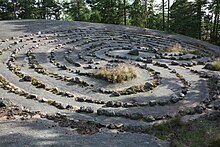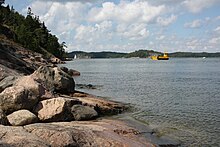Nagu
(Swed.,Finn. Nauvo) is a formermunicipalityand aparish villagein thearchipelagooff the coast of south-west Finland. At the beginning of 2009, Nagu merged with the municipalities ofKorpo,HoutskärandIniöas well as the city ofPargasto form the city of Väståboland, which was renamed Pargas (FinnishParainen)on January 1, 2012.
The area of Nagu was settled by Swedish farmers in the Middle Ages . Early 14th century was Nagu to a chapel congregation of the parish Pargas, the same towards the end of the century then into an independent parish.
Geography and population
The former municipality of Nagu lies west of Pargas and east of Korpo and comprises a total of over 3000 skerries and cliffs, which are located south of Turku in the province of western Finland in the region of Varsinais-Suomi . The Nagu Archipelago is part of the world's largest group of brackish islands with around 100,000 islands, skerries and cliffs in the Finnish, Estonian and Swedish Baltic Seas . The entire municipality extended over 1698.44 km², of which only 250.63 km² mainland , d. H. less than 15%.
In 2007 the population of Nagu Municipality was 1,416, 69.8% of which were Finland-Sweden . During the summer months, however, more than 10,000 other people regularly stay in the area permanently. Officially, the community was bilingual with Swedish as the majority and Finnish as the minority language .
Infrastructure and traffic
Nagu is located around 35 kilometers from Turku on the island of Storlandet , other important islands are Lillandet , Kirjais and Högsar . Most of the islands in the Nagu Archipelago are linked by a network of country roads, bridges and free car ferries. Part of this road network belongs to the Archipelago Road , but ferries also reach the remote islands to the south, where Nagu borders the international waters of the Baltic Sea. The main moorings for these liner boats are in the center of Nagu, in the port on the east side of the island of Kirjais and in the port of Pärnäs in the west of the main island of Storlandet.
Nagu is one of the most important centers for services and tourism in the region. There are sport boat harbors in several places in the archipelago. The largest of these ports is located in the center of Nagu. In addition to the harbor and a church from the 15th century, there are two grocery stores, two banks, petrol stations for cars and boats, a post office, several hotels and a large number of restaurants and souvenir shops. The latter, as well as some of the restaurants, are only open during the summer season.
The center of Nagu is a hub for transport and travel in the archipelago. Regional road 180 ( Skärgärdsvägen ), the road connection between the urban area of Turku and Pargas and the islands in this part of the archipelago, leads over the main islands and through the center of Nagu to Korpo and Houtskär and from Korpo to the Åland Islands . In addition to a large number of bridges, there are several ferry connections on the route. To go from Nagu to Turku , you only have to take a ferry from Nagu's main island to Pargas. The free crossing takes about eight minutes. The Pargas – Nagu car ferry has two to four departures every hour in both directions during the day and one departure every hour at night.
From the center of Nagu there are several daily bus connections in both directions (to Turku and Houtskär). The so-called archipelago bus runs all year round.
Attractions

One of the most important sights in Nagu is the stone church built between 1430 and 1450 , which is located in the center of the village in Kyrkbacken (Eng. "Kirchberg"). The organ from 1791 was built by Olof Schwan and is the oldest organ played in Finland, which still mainly consists of original parts.
Sjöfartshuset (Eng. "Seafarer's House") offers an exhibition on the history of seafaring in Nagu since the 19th century. The guest harbor of Nagu is very popular with recreational yachtsmen and was named "Harbor of the Year" in 1984.

Nagu-nalles egen stig ( Eng . "Nagu-Teddy's Path") is a nature trail for families with small children in the forest right next to the center of Nagu. On the path characters from the popular children's books by the Finnish-Swedish writer Henrika Andersson are shown. Westerholm Trail is a 3 km long cultural trail with information about the landscape painter Victor Westerholm , which starts at the southern harbor in the town center and leads through the forests of the nearby island of Ernholm. The Troy Town of Finby is located about 2 km from the center and can be reached on foot along a marked footpath.
In the north of Nagu is the small island of Själö (Finnish: Seili ), which was a place of exile for lepers from around 1620 to 1785 . Until 1962 the mentally handicapped were accommodated in the hospital in Själö. Själö Church was built in 1733. The part of the hall where the lepers banished to Själö sat during the service is separated. Today the island is home to a biological research station from the University of Turku . Själö can be reached from the port in the center of Nagu with the ferry M / S Östern (only during high season, chargeable) or M / S Falkö (outside high season, free of charge).
Nötö is a small village on the island of the same name in the south of Nagu. The village has a small guest harbor, a shop, a café and a bed and breakfast. There is also a remarkable church on the island of Nötö, the so-called Abraham Chapel , which was decorated by Gustaf Lucander and consecrated on July 2, 1757. Nature trails lead, among other things, to primeval tombs.
Nagu and Germany

Nagu's history is also linked to the history of Germany, which played a role in the Finnish civil war . In the Nagu cemetery there is a memorial to six Germans who fell on the side of the White Army in early April 1918 . The text of the gravestone reads in German translation from Swedish:
“Fallen in the fight for Finland's freedom in the Battle of Lohm on April 4, 1918: Fr. Lambert Köjer; in the battle of Mielis on April 4, 1918: Oberjäg. Anton Halbherr, Gefr. Karl Loose, hunter Friedrich Molz, hunter Wilhelm Vohsen, hunter Herrmann Busse. SFK [ie Skärgårdens Frikår ; German "Freikorps des Schärengarten", a unit of the whites ] erected the monument for his brave comrades in arms from the Grand Ducal Mecklenburg Jäger Battalion No. 14. "
The memorial was unveiled on July 11, 1920 while an orchestra was playing Die Wacht am Rhein , an unofficial national anthem of the German Empire.
Well-known people from Nagu
- Gustaf Lucander (1743–1805), church painter
- Edith Södergran (1892–1923), writer, comes from Nagu on her mother's side
- Victor Westerholm (1860-1919), artist
Individual evidence
- ↑ As of 2008, source: Maanmittauslaitos (Finnish land surveying office) (PDF; 247 kB)
- ↑ As of December 31, 2007, source: Tilastokeskus (Finnish Statistics Office) ( page no longer available , search in web archives ) Info: The link was automatically marked as defective. Please check the link according to the instructions and then remove this notice.
- ^ Kort om Nagu ( sv ) Retrieved October 28, 2019.
- ↑ Tidtabeller för färjor i Finland ( sv ) Retrieved October 28, 2019.
- ↑ Skärgårdsbuss ( sv ) Retrieved October 28, 2019.
- ^ Sjöfartshuset i Nagu ( sv ) Sjöfartshuset i Nagu. Retrieved November 9, 2018.
- ^ Historia ( sv ) Pargas stad. Retrieved November 11, 2018.
- ↑ Sevärdheter ( sv ) Nötö Hembygdsförening. Retrieved November 9, 2018.
- ↑ Minnesmarket över de fallna tyskarna i Nagu . Veckans Krönika 08/07/1920 no 32.1920. Retrieved October 29, 2019.
Web links
- Tarja: Troy Town rock maze in Nauvo archipelago. In: Out in the nature. September 7, 2018 (English, Trojaburg ).
Coordinates: 60 ° 11 ′ N , 21 ° 55 ′ E




